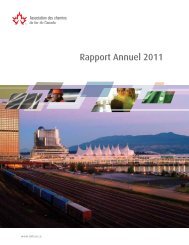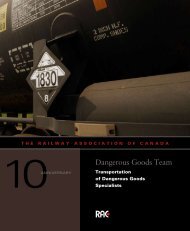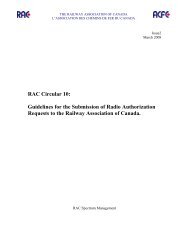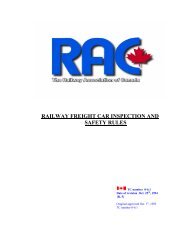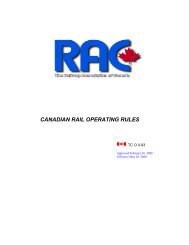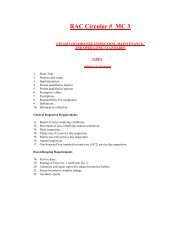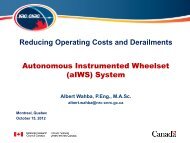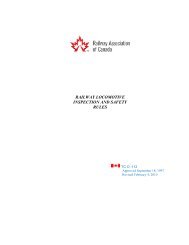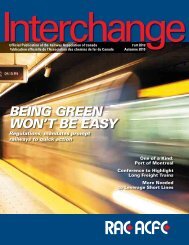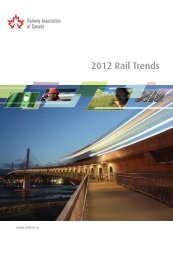Locomotive Emissions Monitoring Program - Railway Association of ...
Locomotive Emissions Monitoring Program - Railway Association of ...
Locomotive Emissions Monitoring Program - Railway Association of ...
Create successful ePaper yourself
Turn your PDF publications into a flip-book with our unique Google optimized e-Paper software.
Figure 10<br />
Total <strong>Railway</strong> GHG <strong>Emissions</strong><br />
kilotonnes <strong>of</strong> CO 2 equivalent<br />
7500<br />
7,500<br />
Total Rail<br />
6500<br />
6,500<br />
Total Freight<br />
5500<br />
5,500 1990 91 92 93 94 1995 96 97 98 99 2000 01 02 03 04 2005 06 07 08<br />
Figure 11 shows the GHG emissions intensities trend line for freight traffic which increased in 2008 to 18.05 kg<br />
per 1,000 RTK from 17.75 in 2007 but decreased from 23.88 in 1990. The yearly values are listed in Table 9. As<br />
a percentage, the 2008 GHG emissions intensity for total freight was 1.7 per cent above 2007 and 23.3 per cent<br />
below 1990 levels.<br />
Figure 11<br />
Total Freight GHG <strong>Emissions</strong> Intensity<br />
kg <strong>of</strong> CO 2 equivalent / 1,000 RTK<br />
30<br />
30<br />
23.3 per cent reduction since 1990<br />
20<br />
20<br />
10<br />
10 1990 91 92 93 94 1995 96 97 98 99 2000 01 02 03 04 2005 06 07 08<br />
The MOU signed on May 15, 2007, between the <strong>Railway</strong> <strong>Association</strong> <strong>of</strong> Canada (RAC), Environment Canada and Transport<br />
Canada (attached as Appendix A) sets out targets to be achieved by 2010 for GHG emissions intensities by category <strong>of</strong><br />
railway line-haul operation. Vis-à-vis the 2010 target, Table 10 shows the emissions intensity levels for the years 2003<br />
to 2008 for, respectively, Class I freight, Regional and Short Lines, Intercity Passenger and Commuter Rail. Except for<br />
intercity passenger operations, the emissions reduction trend rose in 2008 vis-à-vis the 2010 target.<br />
Table 10<br />
GHG <strong>Emissions</strong> Intensities by Category <strong>of</strong> Operation<br />
<strong>Railway</strong> Operation Units 2003 2004 2005 2006 2007 2008 2010 Target<br />
Class I Freight kg / 1,000 RTK 18.16 17.62 17.73 17.79 17.32 17.61 16.98<br />
Regional and Short Lines kg / 1,000 RTK 17.81 18.59 17.46 15.10 15.21 15.80 15.38<br />
Intercity Passenger kg / passenger-km 0.14 0.14 0.13 0.13 0.13 0.12 0.12<br />
Commuter Passenger kg / passenger 1.82 1.89 1.87 1.74 1.71 1.74 1.46<br />
The increase in GHG emissions intensities by the freight railways can be attributed to the 4.2 per cent decrease in<br />
2008 RTK traffic over the 2007 level. In the fourth quarter <strong>of</strong> 2008, the Canadian economy contracted at an annualized<br />
rate <strong>of</strong> 3.7 per cent, which had a direct negative impact on freight railway traffic. During that quarter, RTK traffic<br />
declined 20 per cent on a year-over-year basis.<br />
At the time that GHG emissions intensity targets in the MOU were negotiated, the assumption was that RTK traffic<br />
would grow by 3.0 per cent during the course <strong>of</strong> the MOU. When freight railways experience growth in traffic and use<br />
scheduled railway operations, they have the ability to run longer and heavier trains, thus improving GHG emissions<br />
intensity levels. However, when RTK traffic declines, railways operate shorter and lighter trains, thus resulting in<br />
19 LEM 2008





